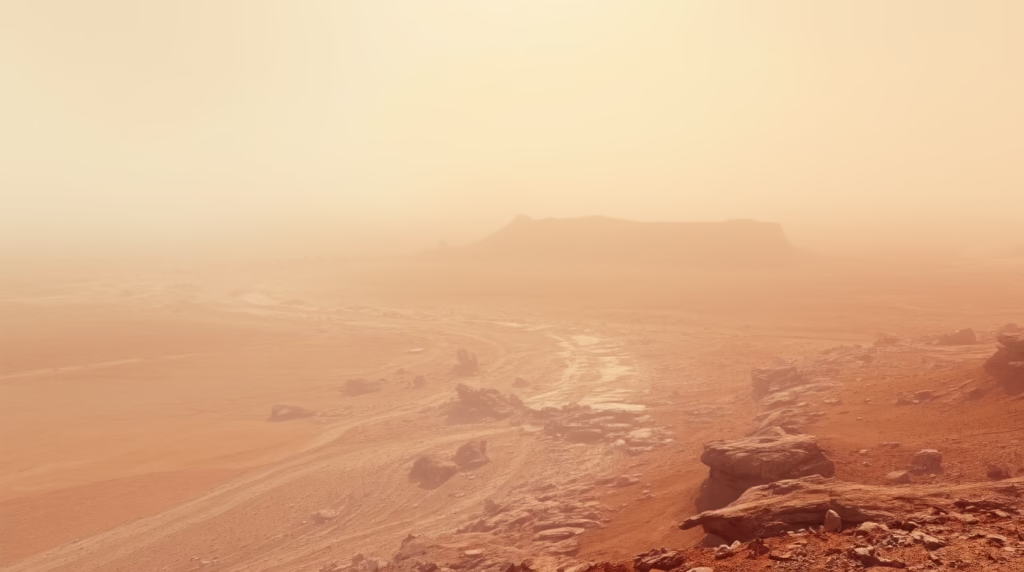Unveiling Mars’ Ancient Shoreline: Evidence for Past Coastal Environments
A groundbreaking study, published in the Proceedings of the National Academy of Sciences (PNAS), has presented compelling evidence suggesting that Mars, contrary to its current arid state, once possessed dynamic coastal environments reminiscent of Earth’s beaches. Utilizing data gathered by the Zhurong Mars rover, an international team of researchers, including experts from Penn State University, have identified subsurface geological formations indicative of an ancient ocean in the northern plains of the Red Planet. This discovery significantly reinforces the hypothesis that Mars once harbored a substantial body of water, potentially fostering conditions conducive to life.
The research hinges on the analysis of layered rock formations detected beneath the Martian surface in Utopia Planitia, the landing site of the Zhurong rover in 2021. Unlike previous Martian exploration missions, Zhurong was equipped with ground-penetrating radar, a sophisticated instrument capable of probing the subsurface using both low and high-frequency radar waves. This technology allowed scientists to visualize and analyze buried geological structures, providing unprecedented insights into the planet’s hidden history.
Benjamin Cardenas, assistant professor of geology at Penn State and a co-author of the study, highlighted the significance of their findings, stating, “We’re uncovering locations on Mars that bear a striking resemblance to ancient shorelines and river deltas.” He emphasized the discovery of evidence for wind, wave action, and abundant sand, painting a picture of “a genuine, vacation-style beach.” This characterization, while evocative, underscores the remarkable similarity between the Martian geological features and terrestrial coastal environments.
The key to this discovery lies in the identification of “foreshore deposits,” layered sedimentary formations that slope downwards towards what was once a vast body of water. These formations are created by the deposition of sediments carried by tides and waves, a process that is fundamental to the formation of beaches on Earth. The radar data revealed a layered structure consistent with these foreshore deposits, indicating the presence of a dynamic interface between air and water.
Cardenas elaborated on the implications of this finding, stating, “This immediately stood out to us because it indicates the presence of waves, which in turn implies a dynamic interface of air and water.” He further emphasized the connection to the origins of life on Earth, noting, “When we consider the environments where the earliest life on Earth evolved, it was within the interplay between oceans and land. Thus, we are observing a potential ancient habitable environment on Mars, one that could have supported conditions favorable to microbial life.”
The researchers meticulously compared the Martian radar data with analogous radar images of coastal deposits on Earth. This comparative analysis revealed striking similarities in the dip angles of the sedimentary layers, further strengthening the argument for a coastal origin. The consistency of these dip angles, falling within the range observed in terrestrial coastal sedimentary deposits, provided strong support for their interpretation.
To ensure the robustness of their findings, the team rigorously considered and ruled out alternative explanations for the observed dipping reflectors. They evaluated the possibility of the formations being the result of ancient river flows, aeolian (wind-driven) processes, or volcanic activity. However, the consistent dipping shape, coupled with the substantial thickness of the sedimentary layers, pointed decisively towards a coastal origin.

Mars’ Dynamic Past
“We are witnessing the evolution of the shoreline of this ancient body of water over time,” Cardenas said. “Mars was a dynamic environment, but we frequently see it as a still image of a planet. Rivers flowed, sediments moved, and landscapes were formed and eroded. This type of sedimentary geology allows us to reconstruct the past landscape, understand its evolution, and, crucially, identify potential locations for the search for past life.”
This discovery provides compelling evidence for a past ocean that covered a significant portion of the Martian northern pole, indicating that Mars was once a significantly wetter planet than it is today. The study also offers valuable insights into the evolution of the Martian environment, suggesting a prolonged warm and wet period that may have spanned tens of millions of years, potentially providing ample time for the emergence and evolution of life.
Michael Manga, professor of Earth and planetary science at the University of California, Berkeley, and a corresponding author on the paper, emphasized the transformative impact of the Zhurong rover‘s capabilities. “The Zhurong rover’s ground-penetrating radar allows us to explore the subsurface of Mars in a way that was previously impossible,” he stated. “This technology enables us to conduct geological investigations that were simply beyond our reach before. These technological advancements are enabling fundamental scientific discoveries, revealing a wealth of new information about Mars.”
The collaborative effort behind this research involved a diverse team of scientists from institutions around the world, including Guangzhou University, the Chinese Academy of Sciences, and Tongji University in Shanghai. The combined expertise of these researchers, coupled with the innovative capabilities of the Zhurong rover, has yielded a significant advancement in our understanding of Mars’ past, bringing us closer to unraveling the mysteries of the Red Planet’s potential to have once harbored life.
More NEWS click BB